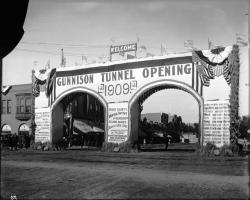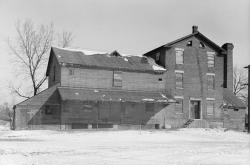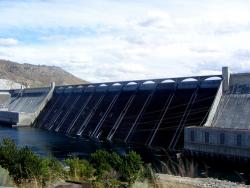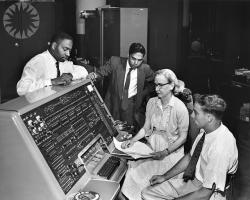In the first nine months of operation, the B reactor produced fissionable plutonium for the world's first atomic bomb (the Trinity test on July 16, 1945), and for the atomic bomb that was dropped on Nagasaki, Japan, on August 9, 1945, killing 35,000 people. This, and similar destruction at Hiroshima caused by the atomic bomb dropped three days earlier, hastened the end of World War II.
USA


At its completion, the 5.8-mile Gunnison Tunnel under western Colorado's Vernal Mesa was the longest irrigation tunnel in America. It carried water from the Gunnison River to the Uncompahgre Valley to irrigate 146,000 acres of cropland.
Work on the 30,582-foot tunnel was first performed manually. Adverse geological conditions provided great challenge for this pioneering project. The drilling crews had to deal with clay, sand, shale, and a badly fractured fault zone.

This is an old technology brought here by new immigrants. It represents the beginning of modern life in a hard wilderness. This wind-powered gristmill was built in 1870 by Fred Meiss, Jr., and Otto Fiek near Spring Creek, from parts of the first windmill in the new state of Texas, erected by E.G. Witte. The millstones are the ones Witte imported from Europe and are believed to be one of the earliest sets in the United States to survive.

On April 21, 1949, a completely outdoor turbine-generator was placed into commercial operation at the Greens Bayou electric power plant--the first fully outdoor unit to operate in the United States. The demand for unprecedented quantities of electricity after World War II pressed utilities to provide addition power quickly. The outdoor design, unlike the traditional large turbine hall, resulted in significant reductions in the cost per kilowatt to build the plant.

A variety of mechanical feeders, including drag-chain conveyors and rotary pocket feeders, historically have been used to volumetrically control the flow of fuel to coal pulverizers on power generators. Most power generation in the United States has relied on burning fossil fuels in steam boilers, with coal as the fuel of choice. By the 1920s, pulverized-firing (the burning in suspension of finely ground coal particles) evolved as means to more complete fuel combustion and higher system efficiencies and facilitated the use of larger boilers.


The massive Grand Coulee Dam, on the Columbia River, is the largest concrete structure in the U.S., the largest hydroelectric facility in the U.S., and the sixth-largest hydroelectric facility in the world. It provides irrigation for up to 1.1 million acres of agricultural lands and the hydroelectric complex maintains a generating capacity of 6.8 million kilowatts. It also serves as the primary flood control for the Columbia River basin (with a capacity of 5.18 million acre-feet of water) and provides recreational opportunities on the 150-mile-long Franklin D. Roosevelt Lake.



Wind dynamics were a major consideration in building such a huge structure. When winds blow against the building, they are deflected up over the roof, creating a partial vacuum that can draw the roof up with a force several times greater than the direct force of the wind. Wind tunnel testing on a model helped designers decide that a semi-parabolic shape would best resolve air current concerns.


